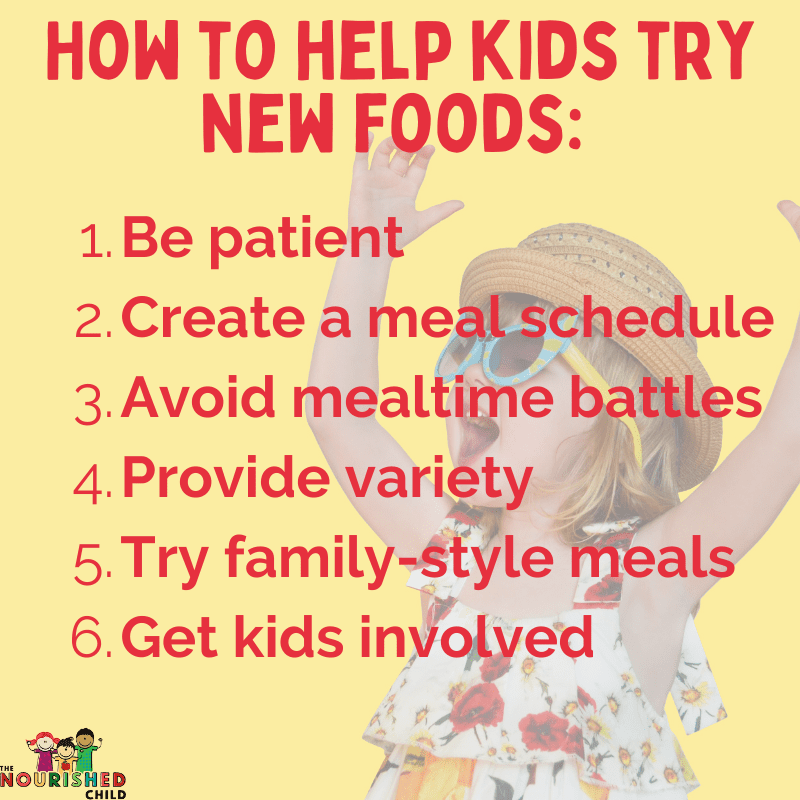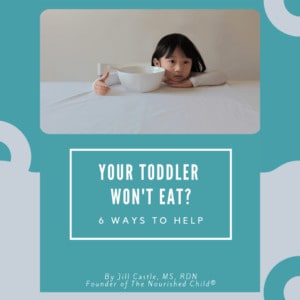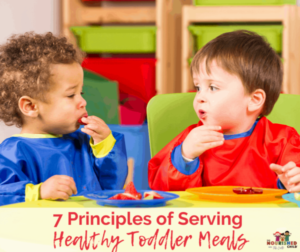The Ultimate Guide to Feeding the Picky Eater
February 22, 2023
Do you have a picky eater in the family? You’re not alone. Picky eating affects almost half of all children. So what do parents need to know about getting a picky eater to eat? Let’s dive in.
In my 32+ years as a children’s nutrition expert, picky eating has been one of the top concern for parents.
I get it. It was a top worry for me, too.
It might surprise you to learn that picky eating is common and a certain amount of pickiness is considered a normal part of development.
Although many parents know about picky eating, they are often unprepared for how challenging and frustrating it can be.
Not surprisingly, food refusal and worrying about your child not eating enough nutritious foods lead to mealtime battles and stress.
So, if your child is a picky eater, keep reading to learn the do’s and don’ts of picky eating and strategies to help them try and eat new foods.
First, let’s dive into the basics of picky eating.

What Is a Picky Eater?
Kids refuse to eat for many reasons. They have food preferences just like we adults do.
In fact, kids have more taste buds than adults, and they naturally prefer sweet flavors and dislike bitter flavors. It makes sense that foods with strong odors and bitter flavors are off-putting to some children.
Unless parents prime their baby’s palate to accept bitter vegetables and spicy flavors, and continue to expose them to a variety of foods, rejecting food may be a predictable eating behavior for toddlers and school-age kids.
Picky eating occurs on a continuum, from mild to extreme. On one end, a child may not prefer certain foods, and at the other end, picky eating can be a feeding disorder.
Every child, their picking eating and degree of food avoidance, is different. In my book, Try New Food, I offer my take on the picky eating continuum.
Pickiness can go from a basic food refusal to a more severe eating challenge that affects a child’s growth and nutritional status.
Typical picky eating
A typical picky eater refuses food here and there. One day your toddler won’t eat a particular food, and the next, they will. They lose interest for a while and then they’ll be open to trying it again. This type of picky eating is common in toddlers and young kids.
Extreme picky eating
Extreme picky eaters eat very few foods and usually only stick to their liked foods, or “safe foods.” As a result, these kids may not get enough nutrients or calories and may not grow well.
Extreme picky eaters usually require treatment with a pediatric dietitian, speech-language pathologist, and/or an occupational therapist.
ARFID (Avoidant Restrictive Food Intake Disorder) in Children
The classification of ARFID was recently changed from feeding disorder to eating disorder. Kids with AFRID refuse to eat certain foods, which is often triggered by an event like choking that causes fear of eating or swallowing, or by heightened sensory sensitivities, for instance.
Unlike other eating disorders, body dissatisfaction are not a trigger for ARFID.
ARFID can be severe, and many kids need medical treatment to stabilize their weight.

Can You Prevent Picky Eating?
Early and frequent exposure to a variety of flavors and foods can help avoid and prevent picky eating. Although, there are no guarantees that your child won’t become fussy with food, or refuse food.
Even if you do everything right, you can still end up with a picky eater. The goal is to get children interested in a variety of food early and to gently re-introduce foods they’ve stopped eating.
Food preferences start as early as infancy.
According to a 2017 review, exposing a child during pregnancy to various flavors through the amniotic fluid and repeated exposures to new flavors during breastfeeding and complementary feeding (or the starting solids phase between 6 months and a year) increases the willingness to try new foods.
What about bottle-fed babies? Try flavor training.
Flavor training primes a baby’s palate to accept flavors, especially the bitter taste of vegetables, which are typically the target of a child’s food rejection.
To flavor train your infant before introducing solids at 6 months, smear a tiny smudge of pureed vegetables on your baby’s lips or add a small dollop to a bottle.
Unlike toddlers, young babies are open to trying new flavors and textures. Offering a variety of flavors during this critical window can help babies accept a wide range of foods when they’re older.
Why Do Picky Eaters Eat the Same Foods?
There’s a reason children’s menus in the U.S. have the same foods: mac and cheese, grilled cheese, chicken tenders, burgers, hotdogs, and pizza. These types of foods appeal to even the most fickle of kids.
What do they all have in common? Kid-friendly foods are highly palatable, meaning they carry a lot of flavor, usually due to sugar, fat and salt. Kid-friendly foods are also familiar and comfortable.
Let’s dive into the top reasons picky eaters stick to a few favorite foods.
Aversion to Colors and Textures
Bland flavors and white or beige-colored foods look safe to kids. These foods have mild flavors and a familiar taste and texture, which can be comforting for picky eaters. And white foods, such as bread, pasta, and rice, are staples in many households, so they’re very familiar.
It’s no wonder children gravitate toward these foods.
Off-putting characteristics of food, like odor, texture, or appearance may contribute to children avoiding food, which is called a sensory aversion.
For example, some children may avoid crunchy or chewy foods because they don’t like the feeling in their mouths, and others may avoid strong odors.
Foods that appear wet, slimy or slippery, like fruits, may also turn off the picky eater.
Kids with sensory aversion are less willing to “eat the rainbow” of fruits and vegetables and as a result, may miss out on many nutrient-rich foods.
Sensory food aversions are common in children with developmental disabilities.
Fear of New Foods
Neophobia is a word that means a fear of new foods, and it’s very common in toddlers.
The lack of exposure to new foods during complementary feeding is a big contributing factor. Kids develop a preference for familiar and predictable foods, especially in the first five years of life.
That’s why I encourage parents to offer a wide variety of nutritious foods from the start.
Negative mealtime experiences are another factor that can lead to food avoidance. I have no doubt parents have good intentions when they request or cajole their kids to eat veggies or finish dinner.
But, anxiety or negative experiences around mealtimes create stress for everyone at the table. And children are more likely to refuse new foods in a negative feeding environment.
Taste preference
Anxiety swirls around neophobia and sensory aversions, but sometimes picky eating is a matter of food preferences that kids develop when they start solids.
Salty, sugary and fatty foods are yummy and more appealing to children. Unfortunately, these highly palatable, minimally nutritious foods displace nutritious foods from a child’s diet. And over time, they may become even more fickle and selective with food.
How to Get a Picky Eater to Try New Foods
Parents want their kids to eat healthfully. Understandably, they also want to avoid mealtime battles. It’s possible to get your little one to try and eat nutritious foods with less stress.
You might think that it’s easier said than done. Changing a child’s eating behaviors takes time and repeated exposure. The key is to have realistic expectations about getting your child to eat without forcing them.
As a parent and pediatric dietitian, I like to bring it back to the basics of Ellyn Satter’s Division of Responsibility. Parents are responsible for when and what a child eats. The parent allows the child to decide if and how much they eat. This strategy eases the turbulence at mealtimes.
Here are some other strategies you can use to encourage your little one to try new foods:
Be patient
You may have to offer food several times before your child is willing to try something new, so be patient and don’t give up. Staying calm benefits your child and allows you to enjoy your meal.
Create a meal schedule
Eating schedules encourage calm and regulated eating in children. Schedules should be predictable but flexible with wiggle room on scheduling. If your child decides not to eat, let them know when the next meal or snack time will be.
Avoid mealtime battles
Don’t allow meals to become a power struggle. The Division of Responsibility makes this doable. When you’re in charge of the menu and serve meals on a predictable schedule, your child will get the nutrients he needs throughout the day and engage their autonomy.
Provide variety
It’s tempting to only offer the foods your child already eats to avoid conflict at mealtime. But, in the long run, accommodating a picky eater’s limited food preferences makes it harder to break the pattern. Instead, introduce nutritious options, such as fruits, vegetables, whole grains, and lean proteins, while limiting exposure to minimally nutritious foods like high-sodium and sugary foods.
Serve meals family style
Family-style meals allow a child to choose what he’d like to eat and how much. And he may be more likely to try something new if he feels he has some control over his plate.
Get kids involved and make meals fun
Let your child help plan meals and offer food in a positive and supportive environment. Make new foods fun and engaging by giving your child age-appropriate cooking tasks.
It’s okay to play with food sometimes. Introduce new foods using fun activities that get your child excited to try something different. For example, have a taste test or let them get their hands dirty by using food to make crafts.
This tactile experience helps kids with sensory aversions learn that food isn’t scary.

Eating Healthy for Picky Eaters
A parent’s biggest worry by far is that their child isn’t eating well enough to be healthy and grow. Throughout my career, sometimes there were reasons for that concern.
However, most of the time, kids do get the nutrients they need from food even when parents think kid-favorite foods aren’t the best choice.
Let’s look at a few picky eater favorites that are healthier than parents might think.
Mac and cheese – make homemade mac and cheese with unprocessed cheddar cheese (bonus, if you use whole grain pasta) and you’re serving a calcium-rich meal. Pasta is an excellent source of B vitamins and is fortified with iron. Also, if you make this with whole wheat pasta, you’ll increase the fiber content of this meal.
Chicken tenders – some frozen nuggets are better options than others. Look for brands made with 100% breast meat and low in sodium. Of course, you can make a homemade version using chicken tender cuts and baking them instead of frying.
Grilled cheese sandwich – like mac and cheese, provides calcium and protein. Serve it with cheddar or Swiss instead of American cheese, and it’s even better for your child.
Pizza – this is the world’s healthiest fast food (at least in the U.S.). The only ingredients are tomato sauce (vitamin C), cheese (calcium), and dough (iron, B vitamins and fiber).
Feeding Mistakes With Fussy Eaters
While I like to focus on the do’s of picky eating, there are some don’ts for parents to avoid.
This list highlights common mistakes to help you notice opportunities to create a positive and supportive environment around food.
Showing frustration and other emotions
Negative comments or emotions and showing frustration around mealtime can be harmful to kids. This creates a stressful environment and leads to more resistance and food avoidance.
Short-order cooking
Short-order cooking, or preparing separate meals for the picky eater, makes mealtimes more stressful. It also reinforces fussy eating behavior that gets harder to break when it persists.
Picky eaters are less likely to try foods served to them when they know there’s another option available.
Hide ingredients
Hiding veggies in your child’s favorite foods may seem like a good way to get them to eat healthy. Instead, these sneaky tactics can backfire. Picky eaters are suspicious and cautious eaters.
Sneaking ingredients into foods may make your kid even more suspicious of new foods and learn not to trust you.
Make dessert a reward
Bribing may work in the short term, but it only reinforces picky eating behavior. It sends the message that healthy foods aren’t yummy and sugary foods are a reward.
The goal is for children to enjoy a wide variety of nutritious foods so they choose to eat them even when you’re not around.
Forcing food or punishing for not eating
Forcing a child to eat or punishing them for not eating makes mealtimes even more stressful for kids. This tactic creates negative associations with food that affect a child’s relationship with food even as they get older.
And it doesn’t work.
In a 2015 study, children of mothers that used covert control over food by not buying low-nutrient processed foods had healthier diets than kids with mothers who overtly controlled food intake.
If you’re concerned that your child is losing weight or has nutrient deficiencies, talk to your pediatrician instead of forcing your child to eat.
Using the “picky eater” label
Many parents might not even realize the consequence of labeling a child for their behavior. Using the label “picky eater” only reinforces the behavior and may make the child feel like they’re expected to have limited food preferences.
Remember, most kids outgrow picky eating, and viewing it as a temporary behavior rather than an inherent trait is more useful.
Don’t give up
Keep offering new foods without pressuring your child to try them. Typical picky eaters will warm up to new foods and old foods they used to enjoy.
Create a positive and supportive mealtime environment, offer a variety of foods in small and manageable portions, and encourage children to explore new foods at their own pace.
Children will taste new foods and have a more nutritious diet with patience and persistence.
Underweight and Picky
Although typical toddler picky eating rarely affects a child’s weight, growth, and development, some studies found that picky eaters have a lower BMI than children who are not picky eaters.
Putting aside the issues with using BMI to measure a child’s health, in this case, using BMI as a measure of comparison suggests that food avoidance can affect growth.
Keep your pediatrician in the loop. If your child loses weight or falls below their growth curve, they might benefit from feeding therapy with a speech-language pathologist and pediatric dietitian.











